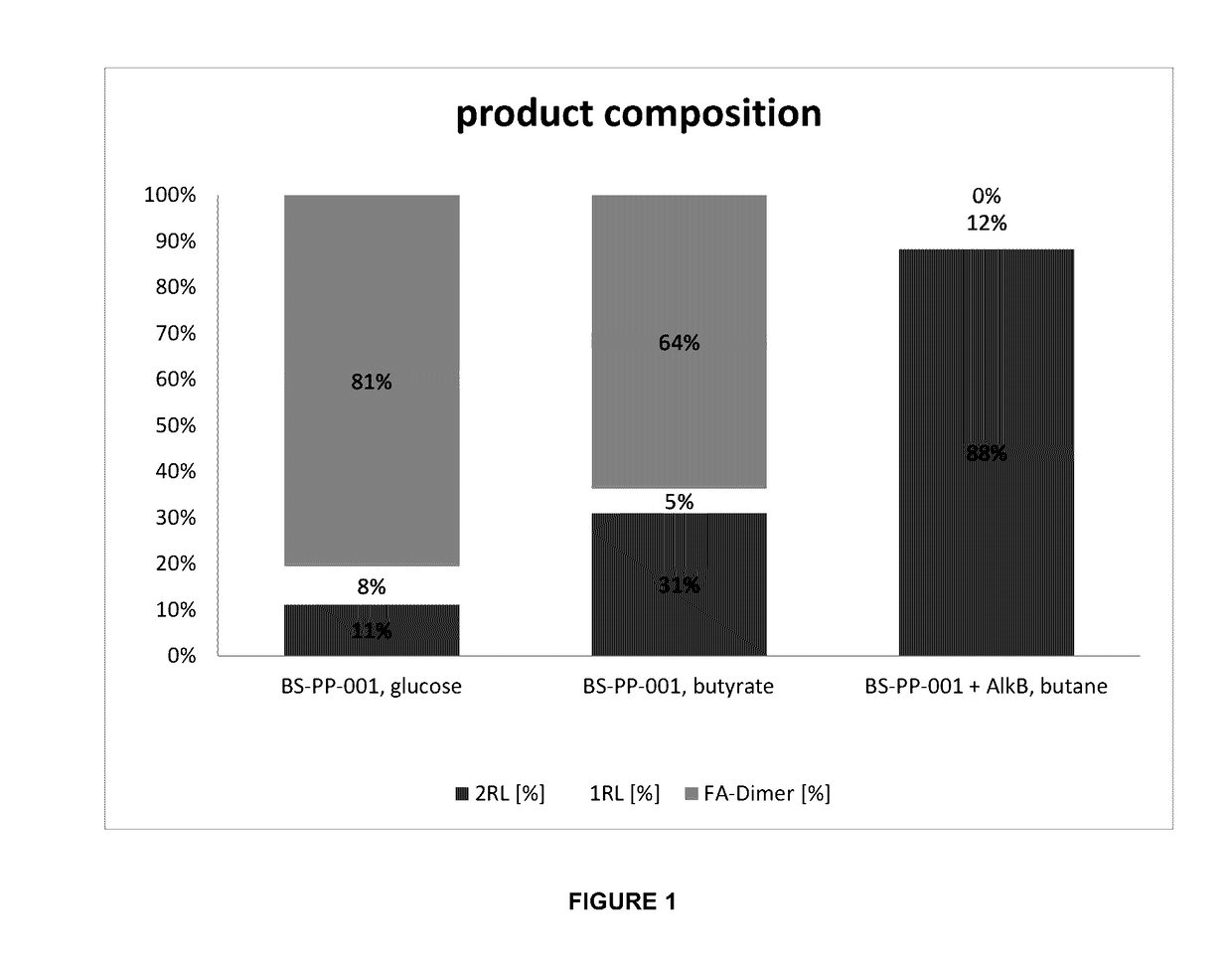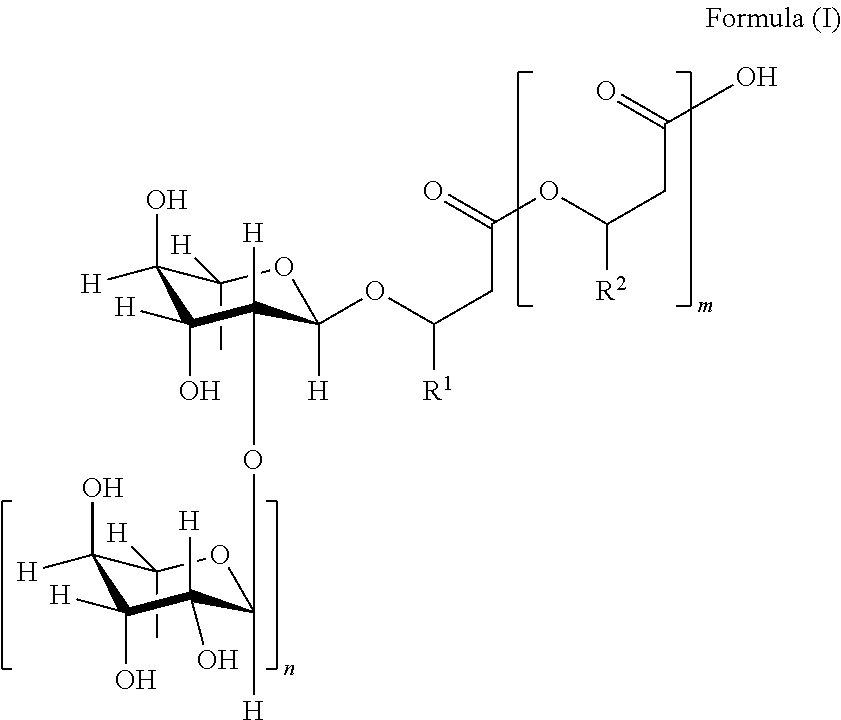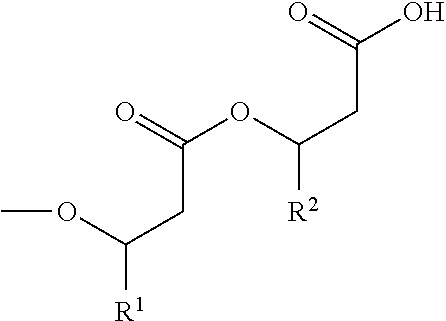Methods of Producing Rhamnolipids
a technology of rhamnolipids and lipids, which is applied in the direction of biocide, enzymology, transferases, etc., can solve the problems of reducing the acceptance of customers for these conventionally produced rhamnolipids, increasing production costs, and higher safety requirements, etc., and vegetable oils are comparatively expensive raw materials in comparison to other carbon sources
- Summary
- Abstract
- Description
- Claims
- Application Information
AI Technical Summary
Benefits of technology
Problems solved by technology
Method used
Image
Examples
example 1 (
A Comparative Example, not of the Invention)
Production of Rhamnolipids with BS-PP-001 from Glucose
[0106]On an LB agar plate containing 50 mg / l kanamycin an inoculation loop of glycerol cryoculture of the strain Pseudomonas putida KT2440 pBBR1MCS-2::ABC (BS-PP-001) was streaked. The method of producing the vector pBBR1 MCS-2::ABC is provided in Example 2 of DE102010032484A1. The Pseudomonas putida is then transformed with the vector and stored. The agar plate was incubated for 24 h at 30° C. A 100 ml flask with baffles containing 25 ml of LB medium with kanamycin was inoculated with a single culture of overgrown agar plate and incubated in a shaking incubator for 24 h at 30° C. and 200 rpm to produce a preculture. The preculture was centrifuged at 5500 g at room temperature for 10 minutes. The supernatant was then discarded. The pellet was resuspended in 25 ml of M9 medium (composition: 6.8 g / l Na2PO4.2H2O, 2.4 g / l KH2PO4, 0.4 g / l NaCl, 1.6 g / l NH4Cl, 0.5 g / l MgSO4.7H2O, 1 ml of trac...
example 2
Production of Rhamnolipids with BS-PP-001 from Butyric Acid
[0109]The preculture was made analogously to Example 1 with glucose.
[0110]In a 300 ml fermenter, 180 ml of M9 medium as described in Example 1 was added with 6.5 g / l sodium butyrate and 50 mg / l kanamycin. The fermenter was inoculated with a large volume of preculture suspension to reach a start OD600 of 0.4. The following parameters were set during fermentation: gassing with air 2 NL / h, stirrer speed set at 300 rpm, temperature 30° C., initial pH value of 7.4 (not regulated throughout the experiment). After 40 h of fermentation, sodium butyrate solution (concentration in the fermenter: 5 g / l butyric acid) was fed via a syringe. The stirrer speed was increased to 900 rpm.
[0111]At specified times, samples were taken from the fermenter to determine the concentration of rhamnolipids and fatty acid dimers produced.
[0112]The results are shown in Table 2 below and FIG. 1.
example 3
Production of Rhamnolipids Using BS-PP-001+alkB from n-Butane
[0113]On an LB agar plate containing 50 mg / l kanamycin, an inoculation loop full of glycerol cryoculture of the strain P. putida pBBR1 MCS-2::ABC pBT10 was (BS-PP001+alkB) streaked. This strain was produced by adding to the strain of Example 1 the gene construct pBT10 as described on pages 36 and 37 (SEQ-ID 31) of WO2009 / 077461A1. The agar plate was incubated for 24 h at 30° C.
[0114]Three 100 ml flasks with baffles was filed with 25 ml of LB medium containing kanamycin and each inoculated with a single culture of the overgrown agar plate and incubated in a shaking incubator for 24 h at 30° C. and 200 rpm.
[0115]Three 1-liter flasks with baffles were each used to mix 75 ml of modified M9 medium (composition: 15 g / l glucose, 6.8 g / l Na2PO4, 3 g / l KH2PO4, 0.5 g / l NaCl, 2 g / l NH4Cl, 15 g / l yeast extract, 0.49 g / l MgSO4×7H2O, 50 mg / l kanamycin sulfate, 15 ml trace element solution US3 consisting of 36.5 g / l of 37% strength hydro...
PUM
| Property | Measurement | Unit |
|---|---|---|
| Fraction | aaaaa | aaaaa |
| Fraction | aaaaa | aaaaa |
| Percent by mass | aaaaa | aaaaa |
Abstract
Description
Claims
Application Information
 Login to View More
Login to View More - R&D
- Intellectual Property
- Life Sciences
- Materials
- Tech Scout
- Unparalleled Data Quality
- Higher Quality Content
- 60% Fewer Hallucinations
Browse by: Latest US Patents, China's latest patents, Technical Efficacy Thesaurus, Application Domain, Technology Topic, Popular Technical Reports.
© 2025 PatSnap. All rights reserved.Legal|Privacy policy|Modern Slavery Act Transparency Statement|Sitemap|About US| Contact US: help@patsnap.com



